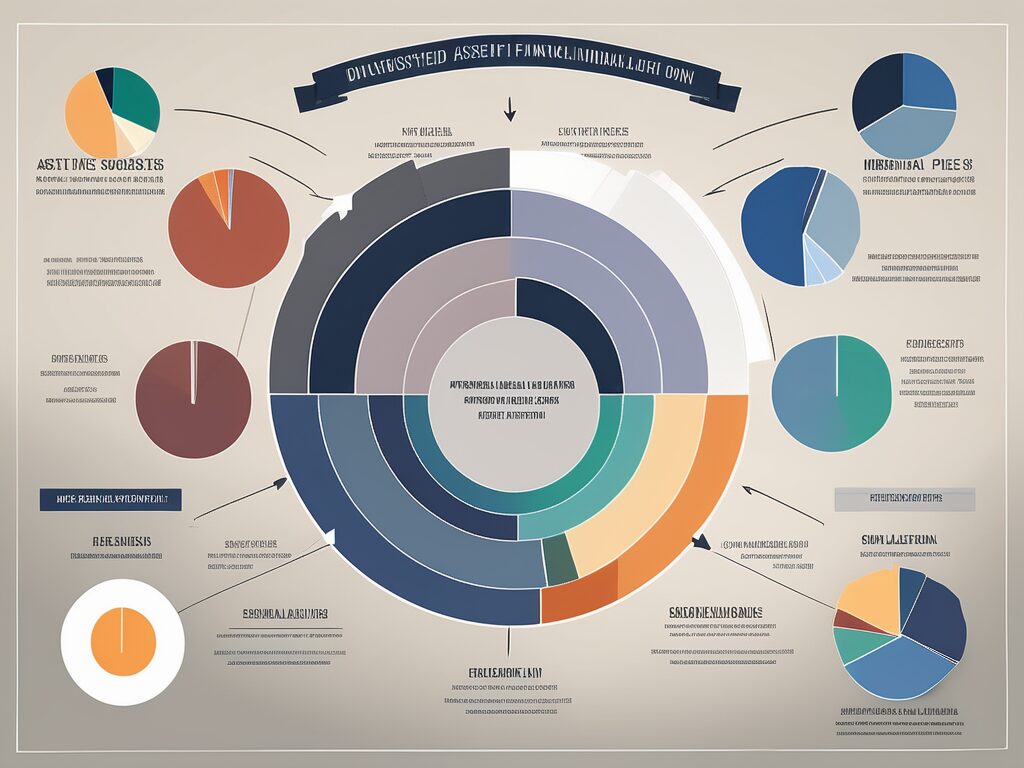
Agent A-Team or Solo Superhero? Finding the Right Real Estate Partner for Your Selling Journey in Wildwood Florida
When it comes to selling your home in Wildwood, Florida,…
January 29, 2024
Asset allocation is a crucial aspect of managing your Individual Retirement Account (IRA) effectively. By strategically dividing your investments across different asset classes, you can aim for a balance between risk and reward, potentially maximizing your returns while minimizing your exposure to volatility. In this comprehensive guide, we will delve into the key principles of asset allocation, assess your risk tolerance, explore various investment options such as mutual funds, index funds, and exchange-traded funds (ETFs), and navigate the world of professional investment services including target date funds and robo-advisors. Additionally, we will discuss how to choose the best IRA account for your retirement goals and provide a step-by-step guide to opening a brokerage account in 2024. So, let’s dive in and master the art of optimizing asset allocation for your IRA.
Asset allocation involves spreading your investments across different asset classes, such as stocks, bonds, cash equivalents, and alternative investments like real estate or commodities. The goal is to achieve diversification, which helps to minimize the impact of any single investment’s performance on your overall portfolio. By diversifying, you can potentially reduce risk while maximizing potential returns.
One key principle of asset allocation is the concept of risk and reward trade-off. Generally, assets with higher volatility, such as stocks, have the potential for higher returns over the long term compared to less volatile assets like bonds. However, stocks also tend to be more susceptible to short-term market fluctuations.
In addition, your investment time horizon plays a crucial role in determining your asset allocation strategy. For example, younger investors with a longer time horizon can afford to take on more risk and allocate a higher percentage of their portfolio to stocks, potentially benefiting from long-term growth. On the other hand, investors nearing retirement may prefer a more conservative allocation to preserve the capital they have accumulated.
Another important aspect to consider when it comes to asset allocation is the correlation between different asset classes. Correlation measures the degree to which two investments move in relation to each other. By including assets with low correlation in your portfolio, you can further enhance diversification and potentially reduce overall portfolio risk. For instance, if stocks and bonds have a negative correlation, when one asset class experiences a decline, the other may experience an increase, helping to balance out the overall performance of your portfolio.
Moreover, it is crucial to regularly review and rebalance your asset allocation. As the market conditions change and your investment goals evolve, your asset allocation may need adjustments. Rebalancing involves selling or buying assets to bring your portfolio back to its target allocation. This process ensures that your portfolio remains aligned with your risk tolerance and investment objectives.
Understanding your risk tolerance is essential when determining your asset allocation strategy. Risk tolerance refers to your comfort level with assuming different levels of investment risk. Factors that influence risk tolerance include your financial goals, time horizon, investment knowledge, and emotional readiness to handle market fluctuations.
Analyze your risk tolerance by assessing your financial goals. Identify your investment time horizon, such as short-term goals (less than five years), medium-term goals (five to ten years), and long-term goals (ten or more years). Consider your ability to recover from short-term market downturns and evaluate how you typically respond to investment losses.
It’s also crucial to be aware of your investment knowledge and comfort with different asset classes. If you lack experience or confidence in a particular investment type, it may be wise to seek professional advice or invest in diversified funds that provide exposure to a range of assets.
Furthermore, understanding your emotional readiness to handle market fluctuations is vital. Investing can be emotionally challenging, especially during periods of market volatility. Consider how you react to market downturns and whether you have the discipline to stick to your investment strategy during turbulent times. Emotional stability is crucial for long-term investment success.
Lastly, it’s important to regularly reassess your risk tolerance as your financial situation and goals change. As you progress in your career, experience major life events, or approach retirement, your risk tolerance may shift. Regularly evaluating your risk tolerance ensures that your asset allocation remains aligned with your evolving needs and objectives.
When it comes to building a strong foundation for your investment portfolio, mutual funds are an essential tool to consider. Mutual funds offer a convenient way to diversify your portfolio while keeping costs low. These investment vehicles typically track a specific market index, such as the S&P 500, or are actively managed by professional fund managers.
Index funds and ETFs (Exchange-Traded Funds) are two popular types of mutual funds that can help you achieve diversification. Index funds aim to replicate the performance of a specific market index, such as the S&P 500, by investing in the same securities that make up the index. On the other hand, ETFs are similar to index funds but trade on stock exchanges like individual stocks, providing investors with more flexibility in buying and selling.
By investing in index funds or ETFs, you gain exposure to a broad range of securities within that index, providing diversification across multiple companies or asset classes. This diversification helps reduce the risk associated with investing in individual stocks or bonds. It means that if one company or sector underperforms, the impact on your overall portfolio is minimized.
One of the key advantages of index funds and ETFs is their passive management approach. Unlike actively managed funds, which involve professional fund managers actively selecting individual securities, index funds and ETFs aim to replicate the performance of the underlying index. This passive approach generally results in lower fees compared to actively managed funds, making them an attractive option for long-term investors.
Index funds and ETFs offer a convenient way to diversify your portfolio while keeping costs low. These investment vehicles typically track a specific market index, such as the S&P 500. By investing in index funds or ETFs, you gain exposure to a broad range of securities within that index, providing diversification across multiple companies or asset classes.
Index funds and ETFs are passively managed, meaning they aim to replicate the performance of the underlying index rather than actively selecting individual securities. This passive approach generally results in lower fees compared to actively managed funds, making them an attractive option for long-term investors.
Moreover, index funds and ETFs provide investors with the opportunity to invest in various asset classes, including stocks, bonds, and commodities. This allows you to create a well-diversified portfolio that can withstand market fluctuations and reduce the impact of any single investment’s performance on your overall returns.
Additionally, index funds and ETFs offer transparency, as their holdings are publicly disclosed on a regular basis. This transparency allows investors to know exactly what they are investing in and make informed decisions about their portfolio.
A balanced mix of stocks and bonds can help optimize returns while reducing overall portfolio risk. Stocks offer the potential for higher returns but come with greater volatility. On the other hand, bonds generally provide more stability and income but have lower growth potential.
When constructing your investment portfolio, it’s important to consider your risk tolerance, time horizon, and financial goals. These factors will help determine the appropriate allocation between stocks and bonds. A younger investor with a longer time horizon may consider a higher equity allocation, while those approaching retirement may prefer a more conservative allocation that prioritizes capital preservation.
One strategy for achieving a balanced mix is to target a specific asset allocation percentage and periodically rebalance your portfolio. This means periodically selling or buying investments to bring your portfolio back to the desired allocation. Rebalancing ensures that your portfolio doesn’t become overly weighted towards one asset class due to market fluctuations.
Furthermore, diversification within each asset class is also crucial. For stocks, you can consider investing in different sectors, such as technology, healthcare, or consumer goods, to spread your risk. Similarly, for bonds, you can diversify across different types, such as government bonds, corporate bonds, or municipal bonds.
By diversifying your portfolio with a balanced mix of stocks and bonds, you can potentially maximize returns while reducing the overall risk. This approach allows you to capture the growth potential of stocks while benefiting from the stability and income provided by bonds.
Target date funds, also known as lifecycle funds, offer a simplified approach to asset allocation. These funds automatically adjust their asset allocation based on your projected retirement date. As you move closer to retirement, the fund gradually shifts towards a more conservative allocation to preserve capital.
Target date funds are ideal for investors who prefer a hands-off approach to asset allocation and want a professionally managed portfolio. They are especially valuable for individuals who lack the time or expertise to monitor and rebalance their investments regularly.
When investing in target date funds, it’s important to consider the fund’s expense ratio, which represents the percentage of your investment that goes towards covering the fund’s operating expenses. Additionally, you should evaluate the fund’s historical performance and compare it to similar funds in the market. This will help you determine if the fund has consistently achieved its investment objectives and if it aligns with your long-term financial goals.
Furthermore, target date funds are not a one-size-fits-all solution. Each fund has a different glide path, which refers to the asset allocation changes over time. Some funds may become more conservative earlier in the retirement timeline, while others may maintain a higher allocation to equities for longer. Understanding the glide path of a target date fund is crucial in determining if it aligns with your risk tolerance and investment objectives.
Robo-advisors are digital platforms that provide automated investment advice and portfolio management. These platforms use sophisticated algorithms to analyze your risk tolerance, goals, and time horizon, enabling them to recommend an asset allocation strategy tailored to your circumstances.
Robo-advisors offer several benefits, including low fees, easy accessibility, and personalized advice. They provide a user-friendly interface that simplifies the investment process and provides ongoing monitoring and rebalancing of your portfolio.
When choosing a robo-advisor, it’s important to consider the platform’s fee structure. Some robo-advisors charge a percentage of your assets under management, while others have a flat fee. Additionally, you should evaluate the investment options available through the platform. Some robo-advisors offer a limited selection of funds, while others provide access to a wide range of asset classes and investment strategies.
Another factor to consider is the level of customization and personalization offered by the robo-advisor. Some platforms allow you to set specific investment goals and preferences, while others provide a more standardized approach. Assessing the level of customization can help ensure that the robo-advisor aligns with your unique financial situation and objectives.
Selecting the right IRA account is crucial for optimizing your asset allocation strategy. Consider factors such as fees, investment options, customer service, and account features when evaluating different IRA providers.
Look for providers that offer a broad range of investment options and low fees, ensuring you can implement your desired asset allocation strategy without excessive costs eating into your returns. Also, research the customer service reputation of various providers, as timely support and assistance can be crucial when managing retirement accounts.
Furthermore, it’s important to understand the different types of IRAs available, such as traditional IRAs and Roth IRAs. Traditional IRAs offer tax-deferred growth, meaning you won’t pay taxes on your contributions or investment gains until you withdraw the funds in retirement. On the other hand, Roth IRAs provide tax-free growth, allowing you to withdraw funds tax-free in retirement, as long as you meet certain requirements.
Additionally, some IRA providers offer additional features and benefits, such as educational resources, retirement planning tools, and access to financial advisors. These features can enhance your overall retirement planning experience and help you make more informed investment decisions.
Opening a brokerage account is a necessary step for investing in individual stocks, bonds, or other investment products outside the scope of mutual funds or target date funds. In this step-by-step guide, we will provide you with a clear roadmap on how to open a brokerage account in 2024, including choosing a suitable broker, completing the application process, and understanding important account features.
When choosing a brokerage account, it’s important to consider factors such as trading fees, account minimums, and the range of investment options available. Some brokers offer commission-free trades on certain securities, while others may have lower fees for active traders. Additionally, evaluate the broker’s research and educational resources, as these can provide valuable insights and help you make informed investment decisions.
Before opening a brokerage account, it’s essential to have a clear understanding of your investment goals and risk tolerance. This will help you determine the appropriate asset allocation and investment strategy for your portfolio. It’s also important to regularly review and rebalance your brokerage account to ensure it remains aligned with your long-term objectives.
To help you take advantage of the benefits of robo-advisors, we have curated a list of the top robo-advisors in the market. We have assessed factors such as fees, investment options, user experience, and portfolio management to help you make an informed decision when choosing a robo-advisor that aligns with your investment goals and risk tolerance.
Our top picks for robo-advisors include platforms that offer a diverse range of investment options, competitive fees, and intuitive user interfaces. These robo-advisors have a track record of delivering strong investment performance and providing excellent customer service. By selecting one of these top robo-advisors, you can enjoy hassle-free investing and peace of mind knowing that your portfolio is being managed by professionals.
In conclusion, optimizing asset allocation for your IRA is essential for long-term financial success. By following the key principles of asset allocation, assessing your risk tolerance, diversifying your portfolio with mutual funds, and considering professional investment services such as target date funds and robo-advisors, you can effectively manage your IRA for a secure retirement. Remember to choose the best IRA account for your needs and open a brokerage account if you wish to venture beyond mutual funds. With this ultimate guide at your disposal, you are ready to take charge of your IRA’s asset allocation and pave the way for a financially prosperous future.

If you want the Richr team to help you save thousands on your home just book a call.
 Book a call
Book a call